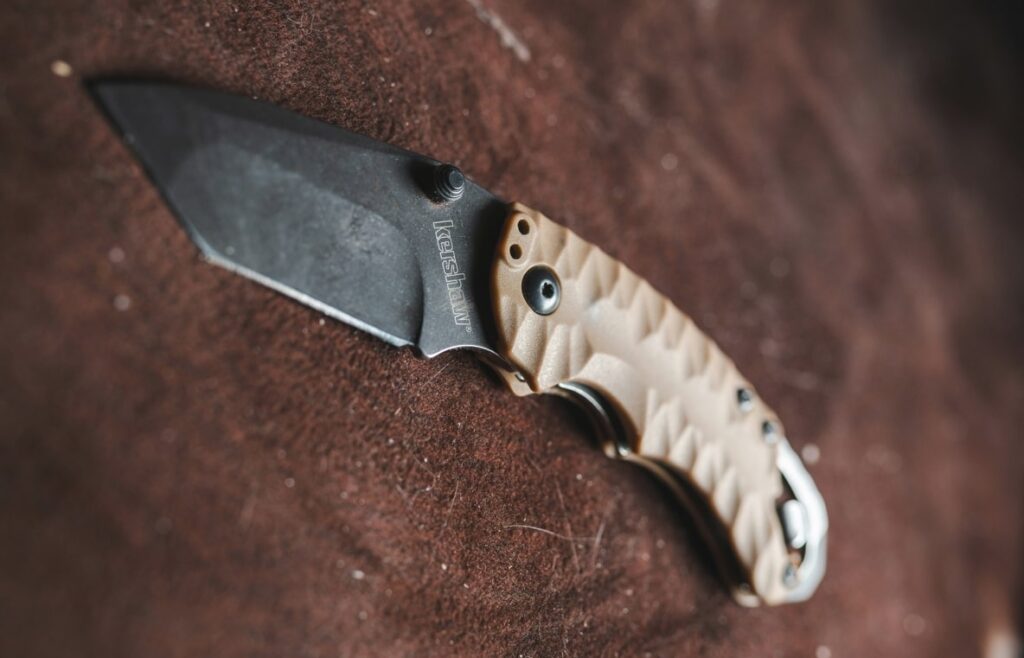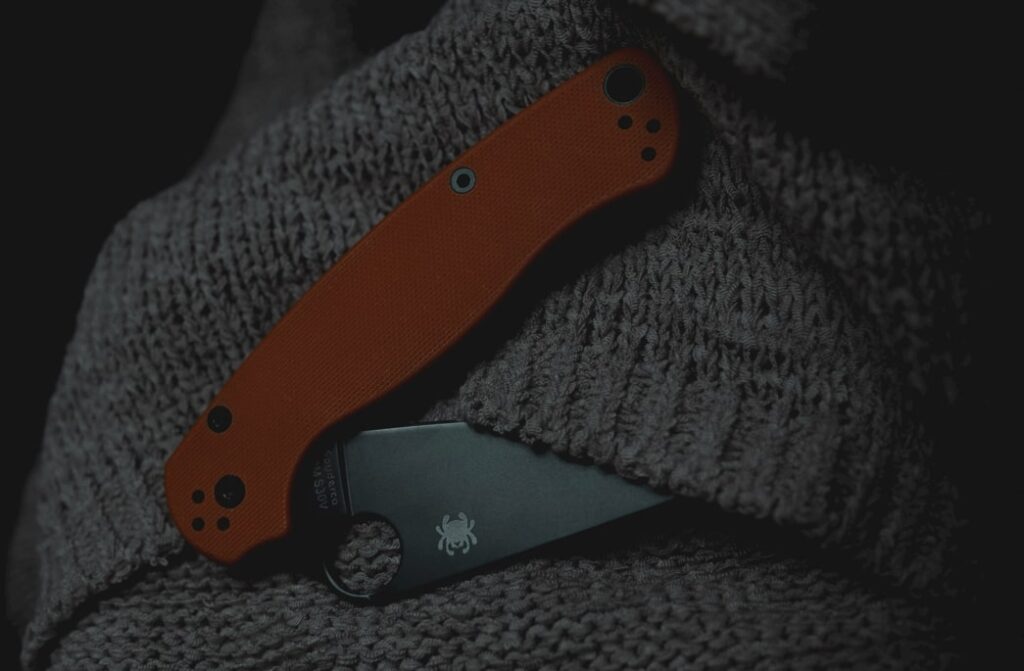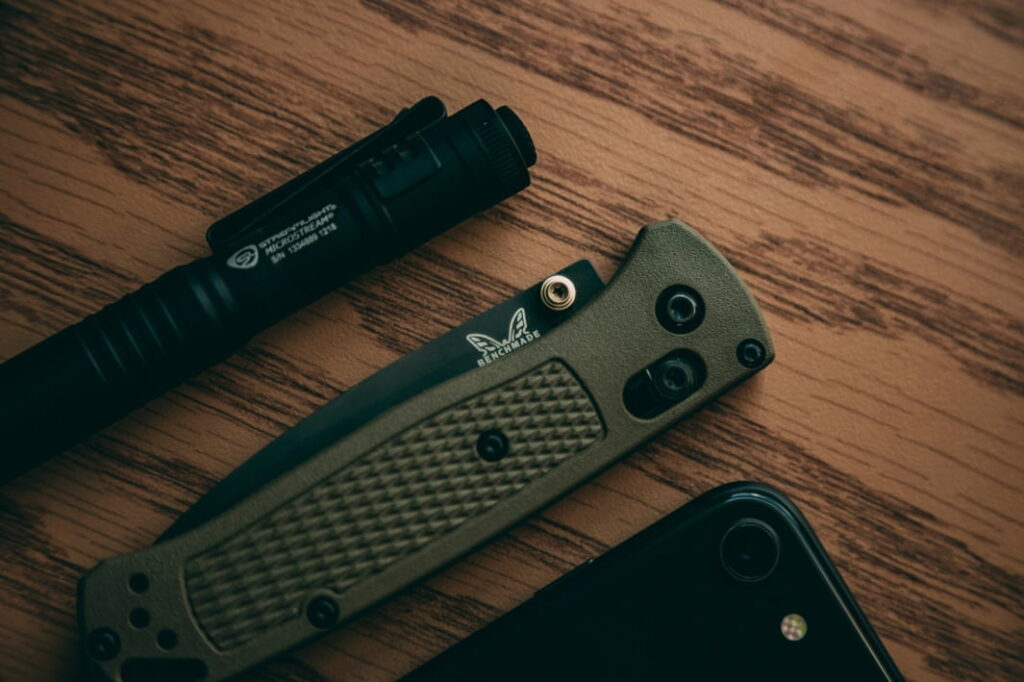The reverse tanto blade offers a practical and durable edge. They are getting popular among knife enthusiasts. Its defining feature is an angular tip similar to the traditional tanto but inverted, hence the term ‘reverse.’ This tip provides additional strength and functionality compared to other blade shapes. The spine of the blade typically has a straight or slightly upward-sloping angle leading to this reinforced tip, contributing to the blade’s structural integrity and piercing capability.
This unique geometry allows for both effective slicing and piercing. Making it a versatile option for various cutting tasks. Its design is not only aesthetically distinct but also serves a utilitarian purpose. Marrying form and function in knife craftsmanship with a style that’s both modern and steeped in tradition. Learn more about the unique features of reverse tanto blades in the rest of the article!
What are tanto blades?
The tanto blade originated from a Japanese short sword used in feudal Japan, called 短刀, meaning ‘short sword.’ It was crafted for armor penetration and close combat. This traditional shape has inspired adaptations like the American tanto and the reverse tanto, which we’ll focus on today.
Reverse tanto vs. traditional tanto vs. American tanto

The traditional tanto blade features a longer spine and a shorter edge curving up to the tip. Providing a characteristic triangular shape. In contrast, the reverse tanto, as its name implies, exhibits an inverted profile, boasting a longer blade edge and a shorter spine that curves upward to meet the tip.
American tanto blades are introduced by Cold Steel. They deviates from the traditional tanto by eliminating the curve at the tip. Instead, it showcases a straight, flat, slanted tip, ideal for piercing tasks. This distinct design variation sets it apart from its Japanese predecessor.
Reverse tanto blade profile
- Angular tip: The most noticeable feature is the hard angle located at the spine instead of the edge, modifying the traditional tanto style.
- Edge profile: Typically, these blades will not have as acute an angle on the spine, making for a more gradual curve up to the tip. This is compared to the classic tanto which shows a more pronounced curve.
- The spine of the blade usually remains straight or has a slight, gradual upward slope, which extends the structural integrity to the tip.
Advantages and disadvantages of reverse tanto blade
Advantages
- Piercing capability: The reverse tanto blade is designed with a strong, angular tip which makes it excellent for piercing tough materials. You’ll find it offers a similar penetration ability as a traditional tanto but with some added slicing benefits.
- Slicing: Thanks to its shape, a reverse tanto blade provides a large cutting area, or belly, that makes slicing tasks easier. This design allows you to execute precise and clean cuts, which can be particularly useful in utility tasks.
- Durable: The unique shape enhances the blade’s strength, offering you a durable knife that can withstand rigorous use. Because of the robust construction, it’s a reliable choice for your everyday carry (EDC).
Disadvantages
- Cutting ability in specific tasks: While the reverse tanto blade is versatile, it may not be the best for all cutting tasks. If you require a knife with a highly curved edge for specific applications, such as skinning, this might not be your go-to blade.
- Utility in fine detail work: Due to its broader tip, you may find that it lacks the finesse required for delicate work where a finer point might be more advantageous.
Consider how these characteristics align with your vision in an EDC knife. The blade’s design can handle a range of materials but bear in mind the potential limitations depending on the task at hand.
Reverse tanto uses

The reverse tanto blade offers a unique profile beneficial for various utility and combat tasks due to its reinforced tip and hybrid design.
Tactical operations and self-defense
In tactical environments, your need for a reliable knife is paramount. Reverse tanto blades are designed with robust tips ideal for piercing through tough materials, which can include body armor when necessary. Their fine points, combined with the strength of the tanto knife design, provide a functional advantage for self-defense situations where precision and strength are critical.
Combat knife considerations
For military personnel, the reverse tanto is a compelling choice as a combat knife. Its angular tip not only excels in piercing ability but also offers a durable edge for the various cutting tasks you may encounter. The blade geometry, which aligns strength at the tip, plays a vital role when engaging in combat scenarios where a knife’s resilience could make the difference.
Camping and hunting scenarios
Reverse tanto blades find their usefulness extended to the great outdoors. Whether you’re preparing kindling for a fire or processing game during a hunt. The combination of a straight edge for slicing and a strong point for piercing makes it a versatile companion. Its utility in cutting ropes, fabric, and even wood demonstrates its multipurpose nature beyond tactical use.
Survival situations
In survival situations, your knife must be ready for anything. A reverse tanto blade’s emphasis on tip strength supports not just piercing, but also armored material penetration if needed. This type of knife can be critical when you are required to craft tools, construct shelter, or procure food, making it a robust choice for enduring the unpredictability of survival challenges.
Knives featuring reverse tanto blades are often constructed with high-quality materials that suit their multi-role capabilities—from detailed work to demanding tasks that test the durability of both the blade and its user.
Reverse tanto blade vs other types of knife blade
Unlike other blade types, the reverse tanto has a straight spine that angles sharply down to the tip, giving it a unique profile. It’s important to understand how such design differs from your other choices before making a decision.
Tanto
Traditional tanto blades feature a straight edge and a sharp angular point, making them excellent for piercing and detailed cutting tasks. However, they can be less effective for slicing due to their limited belly or curve. On the other hand, reverse tanto blades offer a bit more versatility with a slight belly for slicing, but their angled tip isn’t as robust for piercing. Both blade shapes have their strengths and weaknesses, so it really depends on the specific task at hand.
Drop point
Drop point is a classic, widely used blade shape for all knives. Drop point blades feature a curved edge that slopes downward from the spine, creating a large belly for efficient slicing and versatile utility tasks. In contrast, reverse tanto blades boast a straighter edge with a sharp, angular tip, making them ideal for piercing and precision cutting. However, the lack of a pronounced belly on reverse tanto blades can limit their effectiveness for slicing compared to drop point blades.
Sheepsfoot
Reverse tanto blades and sheepsfoot blades share similarities in their design. With both featuring a straight edge and a slightly curved belly. Sheepsfoot blades are also quite similar to spey blade but with a more pointy tip close to edge.
Sheepsfoot blades have a pronounced curve compared to reverse tanto blades. Giving them a distinct appearance and making them more efficient for slicing tasks. The main difference lies in their tips: sheepsfoot blades have a rounded tip close to the edge, while reverse tanto blades maintain a sharp, angular point.
Choosing a reverse tanto blade

Reverse tanto blades are a great choice for knives. The demand for reverse tanto blades has been constant. They look chic, are great for scraping with their broad tip, and excel at various utility tasks.
If you are looking to manufacture reverse tanto blades, keep in mind the importance of making wise decisions regarding the materials for both the blade and handle. Also, consider the specific designs of the knife, including locking and opening mechanisms if you are interested in folding knives. Feel free to contact a professional if you have more questions regarding knife manufacturing and design. Kegani offers a wide range of pocket knives in our catalog, available for mass-production. We can also accommodate your designs and prepare an exclusive manufacturing line for your business!

